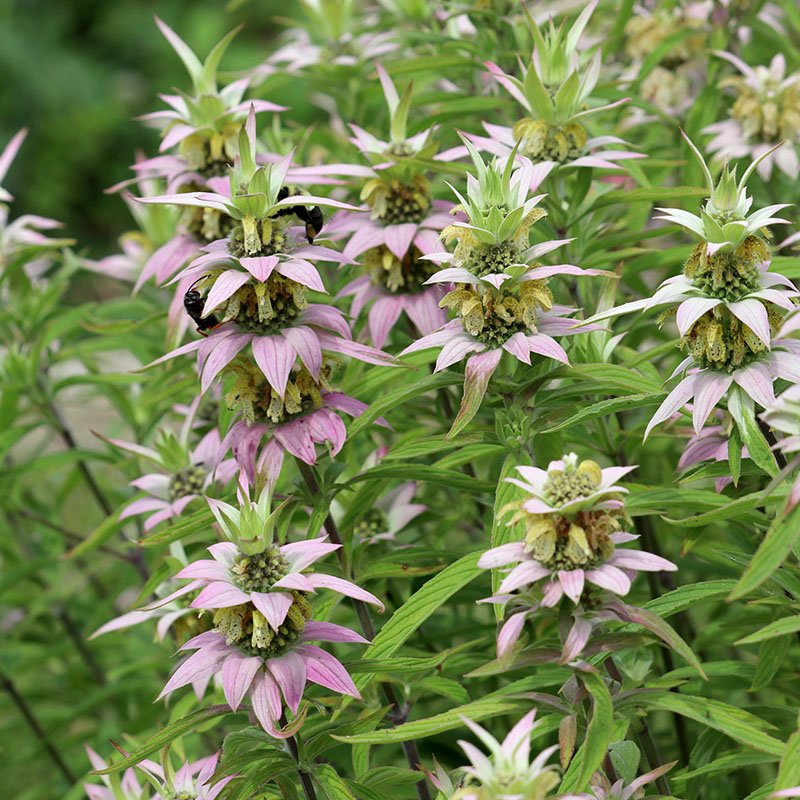 Image 1 of 1
Image 1 of 1


Bee Balm, Spotted
Monarda punctata
Description:
Spotted Bee Balm is the wild child of the mint family—bold, whimsical, and buzzing with energy. This aromatic perennial bursts with stacked whorls of purple-spotted, creamy yellow flowers, cradled by vibrant pinkish bracts that make it a true showstopper in any pollinator garden. Its upright, branching stems and soft, lance-shaped leaves bring both height and texture to native beds, while its spicy scent (think oregano meets thyme) adds an herbal kick to the summer air. Low-maintenance and drought-tolerant, this native powerhouse thrives in poor soils and full sun, making it a favorite for xeriscaping and naturalistic garden designs.
Wildlife Benefits:
True to its name, Spotted Bee Balm is bee-loved. It attracts native bees, butterflies, and hummingbirds in droves. The complex blooms provide easy landing pads for pollinators, while the aromatic foliage is known to repel unwanted garden pests. And come late fall, seed heads offer food for birds—especially finches—bringing biodiversity full circle.
Medicinal Benefits:
Used traditionally by Native American tribes such as the Meskwaki and Winnebago, Spotted Bee Balm is prized for its potent antimicrobial and antifungal properties. Its leaves and flowers can be steeped into a fragrant tea to help relieve colds, congestion, digestive issues, and fevers. Thanks to its high thymol content (yes, the same compound in thyme), it's an herbal go-to for respiratory support and skin infections when infused in oils or salves.
Native Status:
A proud southeastern native, Spotted Bee Balm naturally thrives in sandy prairies, pine barrens, and open fields from Georgia to Texas and up through the Midwest. It plays a vital role in local ecosystems and is a must-have for any garden aiming to support native plant communities.
Pollinator Friendliness:
Spotted Bee Balm’s long bloom time, intricate flower structure, and bold aroma make it an irresistible nectar source for native pollinators, including specialist bees. It's also a larval host plant for some moths and butterflies—making it a true multitasker in your pollinator paradise.
Planting Guidelines:
Height: 1–3 feet
Spacing: 12–18 inches
Sun/Shade: Full Sun preferred, tolerates Partial Shade
How to Grow: Spotted Bee Balm thrives in sandy, well-drained soils and tolerates drought once established. Plant in spring or early fall, water during the first year, and then let nature do the rest. Deadhead to encourage continued blooming, but leave some seed heads at season's end for overwintering birds. Avoid rich soils or overwatering—this native likes it lean and dry.
Spotted Bee Balm is where whimsy meets wellness. Whether you're growing for the pollinators, for personal herbal use, or simply to add a burst of color and charisma to your garden, this plant brings beauty, biodiversity, and botanical benefits all in one.
Available in 4.25 inch (quart) pots and gallon pots
Monarda punctata
Description:
Spotted Bee Balm is the wild child of the mint family—bold, whimsical, and buzzing with energy. This aromatic perennial bursts with stacked whorls of purple-spotted, creamy yellow flowers, cradled by vibrant pinkish bracts that make it a true showstopper in any pollinator garden. Its upright, branching stems and soft, lance-shaped leaves bring both height and texture to native beds, while its spicy scent (think oregano meets thyme) adds an herbal kick to the summer air. Low-maintenance and drought-tolerant, this native powerhouse thrives in poor soils and full sun, making it a favorite for xeriscaping and naturalistic garden designs.
Wildlife Benefits:
True to its name, Spotted Bee Balm is bee-loved. It attracts native bees, butterflies, and hummingbirds in droves. The complex blooms provide easy landing pads for pollinators, while the aromatic foliage is known to repel unwanted garden pests. And come late fall, seed heads offer food for birds—especially finches—bringing biodiversity full circle.
Medicinal Benefits:
Used traditionally by Native American tribes such as the Meskwaki and Winnebago, Spotted Bee Balm is prized for its potent antimicrobial and antifungal properties. Its leaves and flowers can be steeped into a fragrant tea to help relieve colds, congestion, digestive issues, and fevers. Thanks to its high thymol content (yes, the same compound in thyme), it's an herbal go-to for respiratory support and skin infections when infused in oils or salves.
Native Status:
A proud southeastern native, Spotted Bee Balm naturally thrives in sandy prairies, pine barrens, and open fields from Georgia to Texas and up through the Midwest. It plays a vital role in local ecosystems and is a must-have for any garden aiming to support native plant communities.
Pollinator Friendliness:
Spotted Bee Balm’s long bloom time, intricate flower structure, and bold aroma make it an irresistible nectar source for native pollinators, including specialist bees. It's also a larval host plant for some moths and butterflies—making it a true multitasker in your pollinator paradise.
Planting Guidelines:
Height: 1–3 feet
Spacing: 12–18 inches
Sun/Shade: Full Sun preferred, tolerates Partial Shade
How to Grow: Spotted Bee Balm thrives in sandy, well-drained soils and tolerates drought once established. Plant in spring or early fall, water during the first year, and then let nature do the rest. Deadhead to encourage continued blooming, but leave some seed heads at season's end for overwintering birds. Avoid rich soils or overwatering—this native likes it lean and dry.
Spotted Bee Balm is where whimsy meets wellness. Whether you're growing for the pollinators, for personal herbal use, or simply to add a burst of color and charisma to your garden, this plant brings beauty, biodiversity, and botanical benefits all in one.
Available in 4.25 inch (quart) pots and gallon pots
